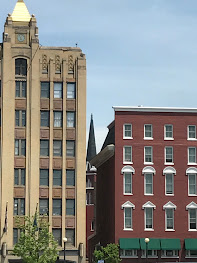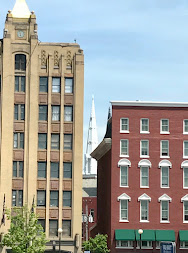P. M. — To Bateman's Pond via Yellow Birch Swamp with Pratt.
Pratt says he saw the first rhodora and cultivated pear out yesterday.
Many are now setting out pines and other evergreens, transplanting some wildness into the neighborhood of their houses. I do not know of a white pine that has been set out twenty-five years in the town. It is a new fashion.
Judging from the flowering of such of the plants as I notice, this is a backward season.
There is a very grand and picturesque old yellow birch in the old cellar northwest the yellow birch swamp. Though this stands out in open land, it does not shed its pollen yet, and its catkins are not much more than half elongated, but it is very beautiful as it is, with its dark-yellowish tassels variegated with brown.
Yet in the swamp westerly the yellow birches are in full bloom, and many catkins strew the ground. They are four or five inches long when in bloom. They begin to shed their pollen at the base of the catkin, as, I think, other birches do.
In the yellow birch and ash swamp west of big yellow birch, I hear the fine note of cherry-birds, much like that of young partridges, and see them on the ash trees.
Viola Muhlenbergii abundantly out, how long?
The fever-bush in this swamp is very generally killed, at least the upper part, so that it has not blossomed. This is especially the case in the swamp; on higher ground, though exposed, it is in better condition. It appears to have been killed in the spring, for you see the unexpanded flower-buds quite conspicuous.
Pratt shows me the fringed gentian stems by a swamp northeast of Bateman's Pond, but we find no traces of a new plant, and I think it must be annual there.
The violet wood-sorrel is apparently later than the Oxalis stricta, not now so forward, lower, and darker green, only a few of the leaves showing that purplish mark.
Hear the pepe, how long?
In woods close behind Easterbrook's place, whence it probably strayed, several Canada plums now in bloom, showing the pink. Interesting to see a wild apple tree in the old cellar there, though with a forward caterpillar's nest on it. Call it Malus cellaris, that grows in an old cellar-hole.
Pedicularis, some time.
The blossom-buds of the Cornus florida have been killed when an eighth of an inch in diameter, and are black within and fall on the least touch or jar; all over the town. There is a large tree on the further side the ravine near Bateman's Pond and another by some beeches on the rocky hillside a quarter of a mile northeast.
In the swampy meadow north of this Pratt says he finds the calla.
The Rubus triflorus is well out there on the hummocks.
The white ash is not yet out in most favorable places.
The red huckleberry looks more forward — blossom-buds more swollen — than those of common there.
Some high blueberry.
Pratt has found perfectly white Viola pedata behind Easterbrook place, and cultivated them, but now lost them.
Says he saw two "black" snakes intertwined (copulating ?) yesterday.
H. D. Thoreau, Journal, May 18, 1857
Pratt says he saw the first rhodora out yesterday. See May 18, 1853 ("The rhodora is one of the very latest leafing shrubs, for its leaf-buds are but just expanding, making scarcely any show yet, but quite leafless amid the blossoms"); May 18, 1855 ("Rhodora; probably some yesterday.") May 18, 1856 ("The rhodora there [Kalmia Swamp] maybe to-morrow. Elsewhere I find it (on Hubbard’s meadow) to-day. ") See also May 14, 1859 ('Rhodora out, says C.")
Viola Muhlenbergii abundantly out, how long? See May 22, 1856 ("Viola Muhlenbergii . . . abundantly out; how long? A small pale-blue flower growing in dense bunches,”)
Pratt says he finds the calla. See June 7, 1857 (“Pratt has got the Calla palustris, in prime. . .from the bog near Bateman's Pond”); June 9, 1857 (“The calla is generally past prime and going to seed. I had said to Pratt, "It will be worth the while to look for other rare plants in Calla Swamp, for I have observed that where one rare plant grows there will commonly be others." ”); July 2, 1957 (" Calla palustris . . . at the south end of Gowing's Swamp. Having found this in one place, I now find it in another.”); September 4, 1857 (To Baeman’s Pond . . .Arum berries ripe.”)
Pratt has found perfectly white Viola pedata . . . but now lost them. See May 18, 1854 ("The V. pedata beginning to be abundant. "). May 20, 1852 ("the V. pedata is smooth and pale-blue, delicately tinged with purple reflections").
Judging from the flowering of such of the plants as I notice, this is a backward season. The white ash is not yet out in most favorable places. See May 18, 1853 ("White ash fully in bloom.")





No comments:
Post a Comment